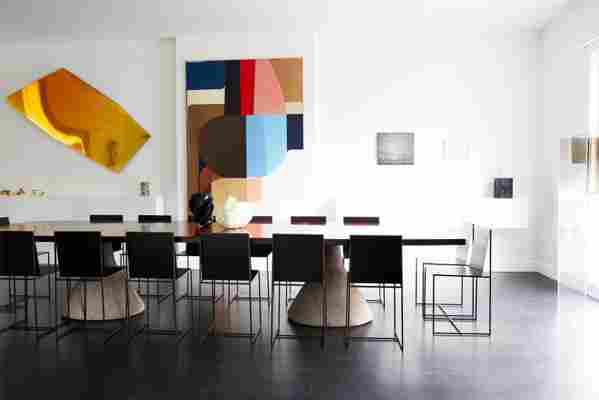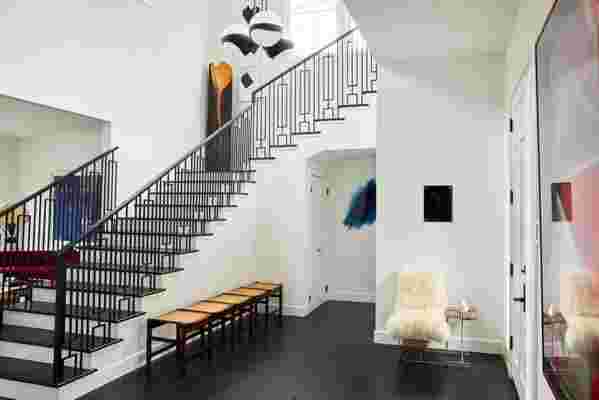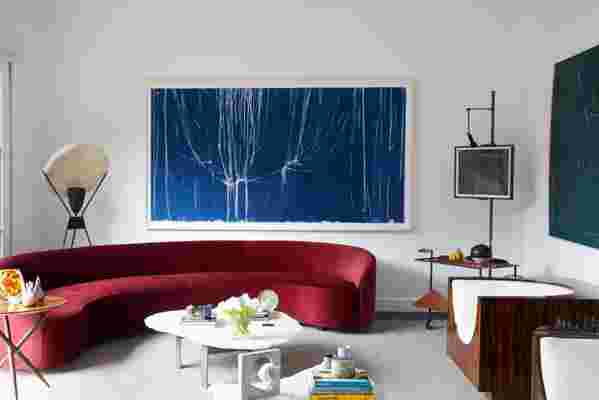Brazilian design dealer Ulysses De Santi and his husband, Graham Steele, didn’t normally spend long periods of time together. They had different responsibilities, and very different rhythms. “Graham is extremely social, hyperactive, and his schedule was always insane,” says De Santi, who’s been sheltering at home with Steele since the pandemic upended life as we know it. “So just to be able to have him here is such a gift.” As a senior director at Hauser & Wirth, an art gallery with outposts in Asia, Europe and North America, Steele was used to jetting across the globe, sometimes having breakfast in one continent and dinner in another. By contrast, De Santi is an introvert. “He would happily be socially isolating for the next five years,” says Steele, only half-jokingly.
The couple’s personality contrasts extend to their design sensibilities: One is a minimalist and the other a maximalist. And yet in the process of moving into their West Hollywood home, a 1930s hillside residence surrounded by greenery, they were able to find a happy medium, influencing each other in subtle and not-so-subtle ways. Steele, an avid art collector, has developed a greater appreciation for abstract works (rather than figurative ones), which complement De Santi’s modernist furnishings from Brazil. And De Santi, to a point, has become more tolerant of decorative exuberance. “My husband is a collector at heart—he keeps buying ceramics, ornaments, and artworks, and he loves to display all of these things,” he says. “I love them too, but my greatest passion is design and I prefer to show my pieces as purely as possible.”

The gallery-like dining room features a series of striking contemporary artworks, including an untitled multicolored oil on canvas by Svenja Deininger and a golden wall sculpture by Nicola Martini (made of wax and bithumen on plexiglas). A table from the 1960s, designed by Jorge Zalszupin with a jacarandá top and sturdy concrete bases covered in suede, quietly anchors the space. The minimalist metal chairs, called Slim Sissi, were designed by Maurizio Peregalli for Zeus Noto .
Shortly after relocating from São Paulo to Los Angeles, De Santi found his true calling as a dealer of Brazilian furniture from the ’50s and ’60s. The former actor and television producer already owned a handful of pieces by important postwar designers, yet he’d never thought of turning his affection for modernismo brasileiro into a business—not until friends in L.A. began to show interest. “People would come over to our first house and ask, ‘Where did you get this?’ They were so impressed,” he says. “I thought, ‘You know what, I’m going to go back to Brazil and then do a pop-up here.’”
In 2016, together with a partner, De Santis unveiled “Studio 55,” a monthlong exhibition on Melrose Avenue where he sold dozens of vintage pieces by icons like Sergio Rodrigues, Geraldo de Barros, Jorge Zalszupin, and Joaquim Tenreiro. That event was followed by two more pop-ups in California and one in Hong Kong.
It’s no surprise, then, to see the couple’s home filled with covetable pieces from one of the most fertile periods of Brazilian art and design. During the mid-20th century, Brazil produced a bevy of geometrically shaped furnishings in jacarandá, a richly veined local rosewood that has since become endangered. In the living room, a set of chairs by Jorge Zalszupin, with perfectly cubic wooden frames interrupted by cushioned scoops, command our attention. Next to them is a tea trolley, also by Zalszupin, with slim but oversized brass wheels and a tray with triangular sides that fold up like origami. “He’s the designer whose work I first fell in love with,” says De Santi, “followed by Sergio Rodrigues.” A round side table designed by Rodrigues, which has three interlocked legs, was placed next to the living room’s curvilinear velvet sofa. The space, like the rest of the house, has a clean, almost gallery-like feel, yet it’s neither sober nor restrained. There is plenty of color (scarlet in the sofa, cobalt in the large-scale cyanotype by Christian Marclay) along with an abundance of shapes and textures. Much like De Santi and Steele’s union, it’s a combination that works.


“We bring out the best in each other—I’ve become a more interesting person since I met him,” says De Santi. To which his husband replies: “He was always interesting, but he’s certainly a bit more social than he was before.” Though the couple are enjoying each other’s company, they are also eager to resume their lively dinner parties, which would often spill out into the house’s lush garden, with bossa nova beats playing in the background.
